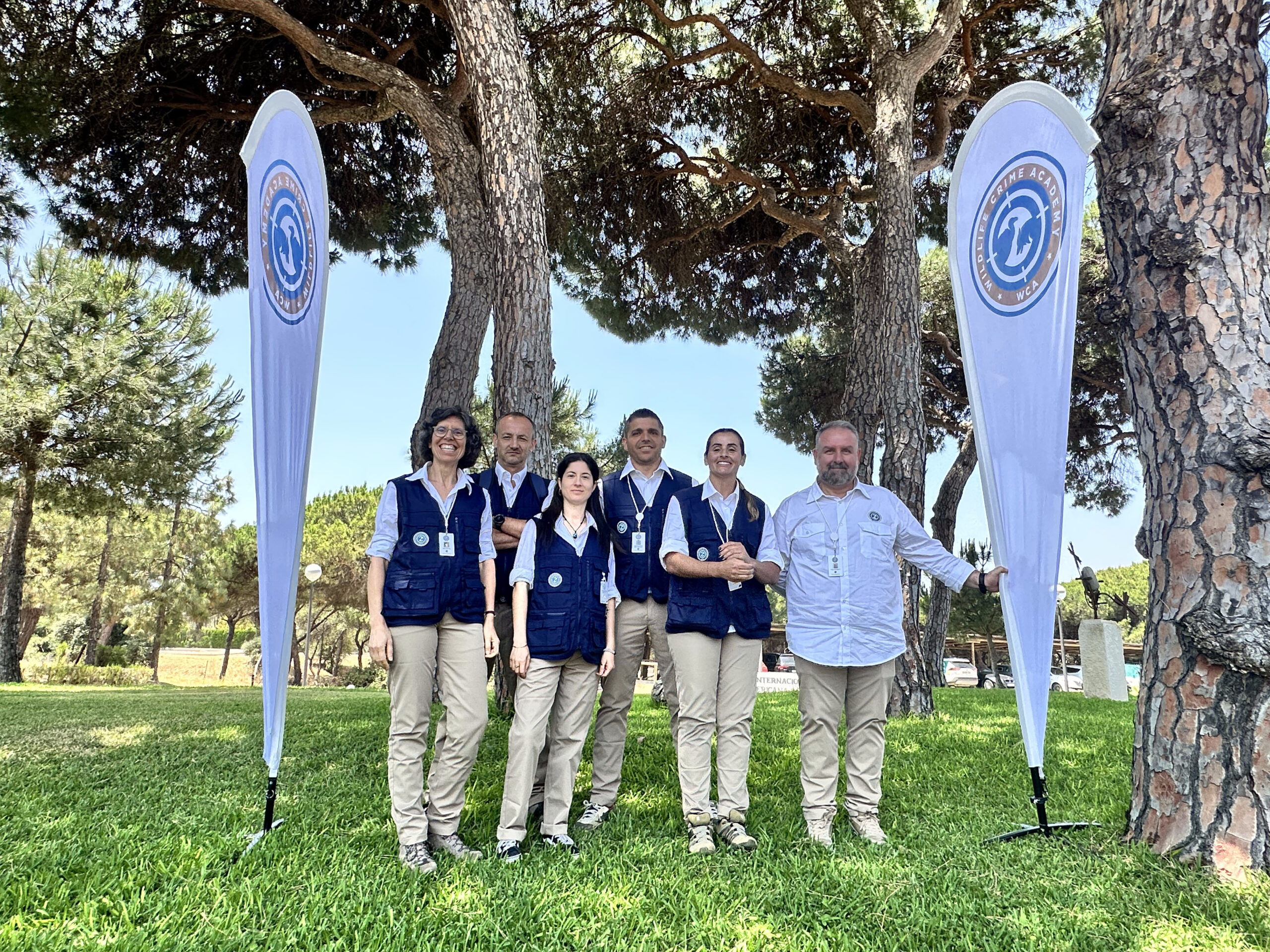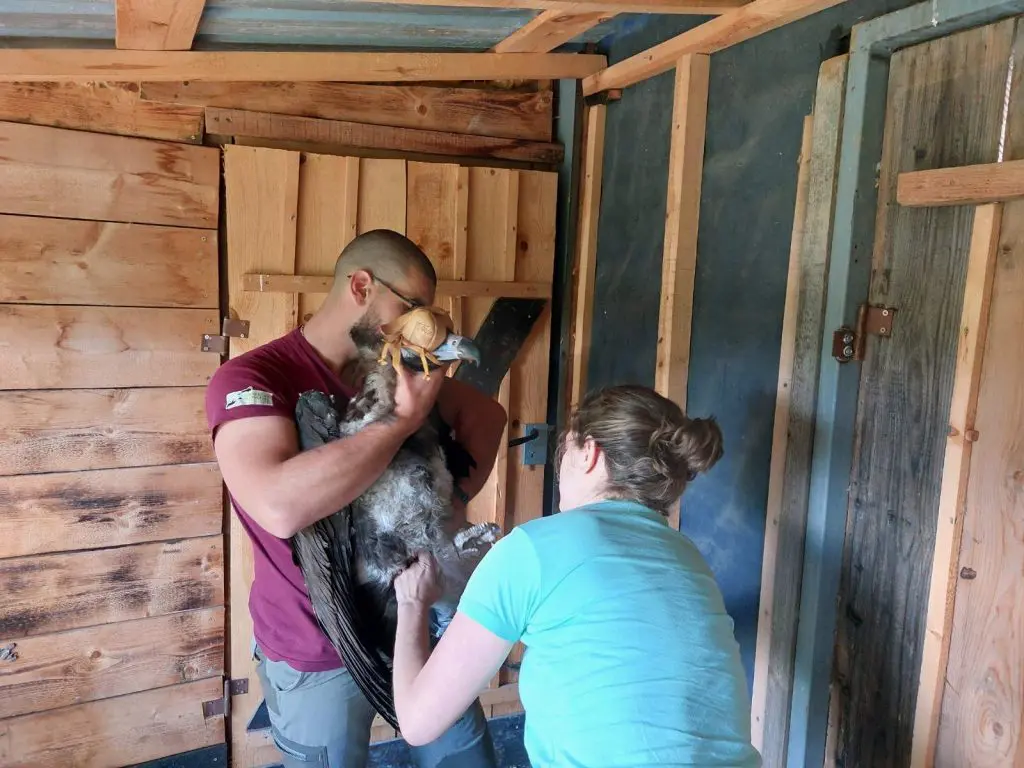Following the discovery of a fifth breeding colony by the ICNF, the LIFE Aegypius Return project ensures the continuous monitoring of the colony’s only chick.
The discovery of a new colony
It was a normal day monitoring Golden eagles (Aquila chrysaetos) under the Alentejo heat in Southern Portugal. At Herdade do Monte da Ribeira, in the municipality of Vidigueira, Nuno Ventinhas spotted a dark blot at the top of a stone pine tree (Pinus pinea), surprised and at the same time doubting what he was seeing. He immediately shared the information and some images with his colleague Carlos Carrapato, who reported the good news to the LIFE Aegypius Return project team.
The fifth Cinereous Vulture (Aegypius monachus) breeding colony in Portugal was just discovered!
Nuno Ventinhas is a technician at the Centre for Migration Studies and Bird Protection (CEMPA) of the Institute for Nature Conservation and Forests (ICNF, the Portuguese nature conservation authority) and works regularly with ICNF’s Regional Delegation of Alentejo, where Carlos Carrapato is part of the Regional Department for Nature Conservation and Biodiversity. Despite their many collaborations in biodiversity monitoring work, they certainly didn’t expect this discovery, or at least that it would happen so soon in that region.
The importance of the finding justified a prompt new visit, reinforced by a team of ICNF technicians and formalised by a meeting with the owners of the estate. New field prospections resulted in the confirmation of four Cinereous Vulture nests, one of them with a chick – the “blot” observed on the previous field trip.
Science as a conservation tool
The Cinereous Vulture, a scavenger bird currently classified as Endangered in Portugal, became extinct in the country in the 1970s as a breeding species. Thanks to conservation efforts and legal measures, it began to recover in Spain and naturally recolonised Portugal in 2010, with the first breeding pairs settling in the Tejo Internacional Natural Park. Since then, more pairs have started nesting in different regions, and until now four breeding colonies were known in Portugal (Douro Internacional, Serra da Malcata, Tejo Internacional and Herdade da Contenda). All these colonies are located very close to the Spanish border, with the fifth and newest colony being the furthest west.
The new colony is thus the westernmost in the species’ distribution range in the world.
The images captured by the ICNF made it possible to estimate the age of the only chick detected in this new colony, which is fundamental information for the next steps. A small team, made up of technicians from the ICNF, the LPN (Liga para a Protecção da Natureza, a LIFE Aegypius Return partner NGO) and biologist Carlos Pacheco, then proceeded to capture and tag the chick as soon as it reached the right age (and size) to receive a GPS/GSM transmitter. This device will now allow the LIFE Aegypius Return team to monitor all the chick’s movements and behaviour in detail. Tagging also consists of fitting numbered rings, which are kind of an identity card for the bird, and provides relevant information whenever there is a new capture or close observation.



The field work also included the collection of biological samples by LPN’s veterinarian, David Delgado Rodríguez, who has ensured that a standardised protocol is applied to all the project’s tagged birds. This way, the team will obtain comparable reference information on biochemical and toxicological parameters, among others, that will support actions to mitigate threats and conserve the species in general, and the recovery of weakened individuals who enter wildlife recovery centres.

Co-operating to rescue a species from extinction
After four decades without Cinereous Vultures breeding in Portugal, in 2022 the country was home to around 40 breeding pairs. This fragility led to the approval of the LIFE Aegypius Return project, which has a budget of 3.7 million euros, 75% co-financed by the European Union. The project aims to expand and consolidate the return of the Cinereous Vulture to Portugal and western Spain, and one of its objectives was to double the breeding population in Portugal, from 40 pairs in 4 known colonies in 2022 to at least 80 pairs in 5 colonies by 2027. The first goal was achieved last year with 79-81 pairs recorded, and the latter was recently accomplished with the discovery of the new colony. In addition to the discovery of the fifth colony, the partners and organisations that collaborate in monitoring the species across the country also registered an increase in the number of nesting pairs compared to last year.
Despite these very encouraging results, the project partners will not rest, as it is necessary to ensure that the species is able to remain in the country in the long term. To do so, it is necessary to guarantee high breeding success, quality and undisturbed habitat, food availability and a reduction in mortality factors, such as illegal poisoning and direct persecution.
For the success of the project, and the conservation of the Cinereous Vulture, co-operation between multiple entities and sectors of activity will be essential, and the project partners would like to thank everyone who has been involved in these efforts. For this tagging in particular, thanks are due to the ICNF and Herdade do Monte da Ribeira.

The LIFE Aegypius Return project is led by the Vulture Conservation Foundation in collaboration with Palombar – Conservação da Natureza e do Património Rural, Herdade da Contenda, Sociedade Portuguesa para o Estudo das Aves, Liga para a Protecção da Natureza, Associação Transumância e Natureza, Fundación Naturaleza y Hombre, Guarda Nacional Republicana and Associação Nacional de Proprietários Rurais Gestão Cinegética e Biodiversidade.



